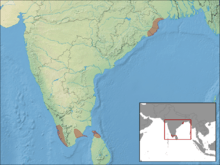Eutropis bibronii
Eutropis bibronii, also known commonly as Bibron's skink or the seashore skink, is a species of skink, a lizard in the family Scincidae. The species is endemic to India and Sri Lanka.[2]
| Eutropis bibronii | |
|---|---|
| Scientific classification | |
| Kingdom: | Animalia |
| Phylum: | Chordata |
| Class: | Reptilia |
| Order: | Squamata |
| Family: | Scincidae |
| Genus: | Eutropis |
| Species: | E. bibronii |
| Binomial name | |
| Eutropis bibronii (Gray, 1838) | |
 | |
| Synonyms[2] | |
Etymology
The specific name, bibronii, is in honor of French herpetologist Gabriel Bibron (1806–1848).[3]
Description
The head of E. bibronii is somewhat flattened. The lower eyelid has a transparent disk. The scales on the dorsum and flanks are sharp, numbering 5–7. The scale rows at midbody number 28–30. There are 14–20 lamellae under the fourth toe. The dorsum is olive brown, with a light vertebral stripe which is dark-edged. A dark dorso-lateral stripe runs from the eye to the base of the tail.[4]
Ecology
E. bibronii inhabits sea beaches, and is active by day on sand. It is adapted for running and diving in the sand.
References
- De Silva A, Srinivasulu C, Srinivasulu B (2013). "Eutropis bibronii ". IUCN Red List of Threatened Species. 2013. Retrieved 30 January 2015.CS1 maint: multiple names: authors list (link) CS1 maint: ref=harv (link)
- Species Eutropis bibronii at The Reptile Database www.reptile-database.org.
- Beolens, Bo; Watkins, Michael; Grayson, Michael (2011). The Eponym Dictionary of Reptiles. Baltimore: Johns Hopkins University Press. xiii + 296 pp. ISBN 978-1-4214-0135-5. (Mabuya bibronii, p. 25).
- De Silva A, Sandaruwan WMJ, De Zoysa HKS, Ukuwela KDB (2017). "An authentic record of Eutropis bibronii (Gray, 1838) (Reptilia: Scincidae) from Sri Lanka". Zootaxa. 4329 (2): 175–182. Retrieved 31 January 2019.CS1 maint: multiple names: authors list (link)
Further reading
- Boulenger GA (1890). The Fauna of British India, Including Ceylon and Burma. Reptilia and Batrachia. London: Secretary of State for India in Council. (Taylor and Francis, printers). xviii + 541 pp. (Mabuia bibronii, p. 184).
- Das I (1991). "A new species of Mabuya from Tamil Nadu State, Southern India (Squamata: Scincidae)". Journal of Herpetology 25 (3): 342–344.
- Gray JE (1838). "Catalogue of the Slender-tongued Saurians, with Descriptions of many new Genera and Species [Part 2]". Annals and Magazine of Natural History, First Series 2: 287–293. (Tiliqua bibronii, new species, p. 25).
- Mausfeld P, Schmitz A, Böhme W, Misof B, Vribradic D, Freder C (2002). "Phylogenetic Affinities of Mabuya atlantica Schmidt, 1945, Endemic to the Atlantic Ocean Archipelago of Fernando Noronha (Brazil): Necessity of Partitioning the Genus Mabuya Fitzinger, 1826 (Scincidae: Lygosominae)". Zoologisher Anzeiger 241: 281–293.
- Smith MA (1935). The Fauna of British India, Including Ceylon and Burma. Reptilia and Amphibia. Vol. II.—Sauria. London: Secretary of State for India in Council. (Taylor and Francis, printers). xiii + 440 pp. + Plate I + 2 maps. (Mabuya bibroni, p. 260).
